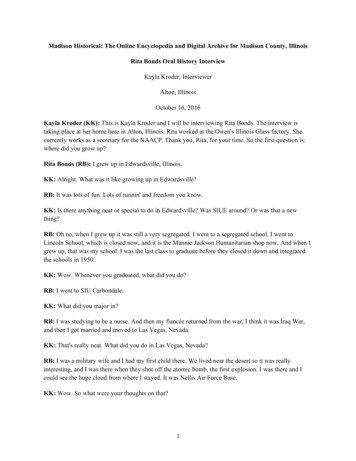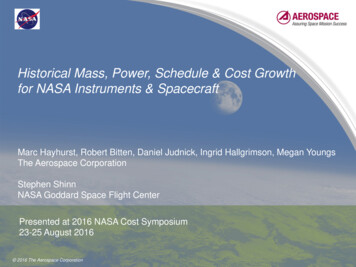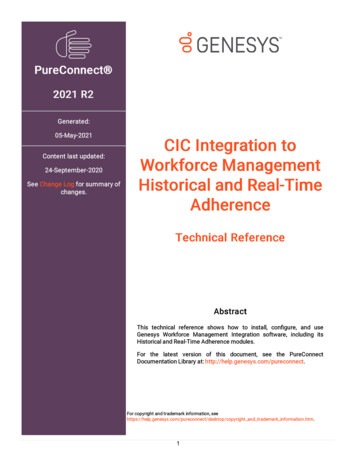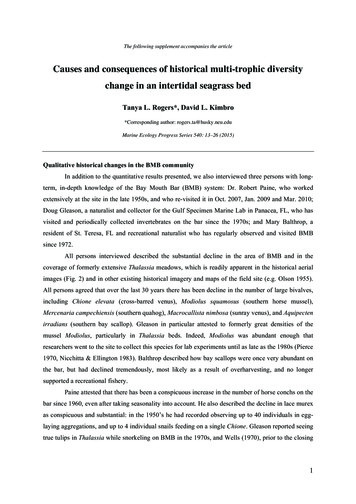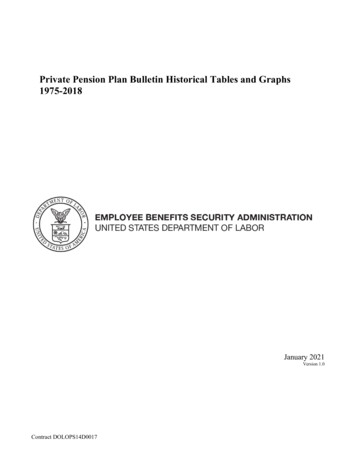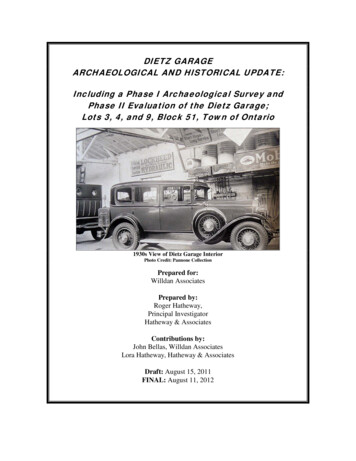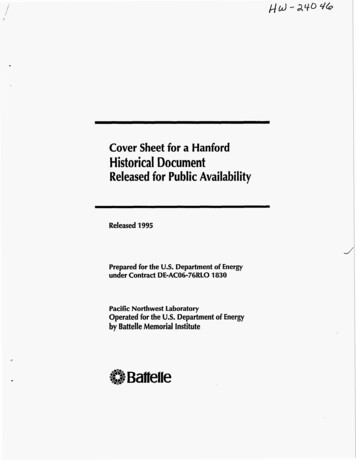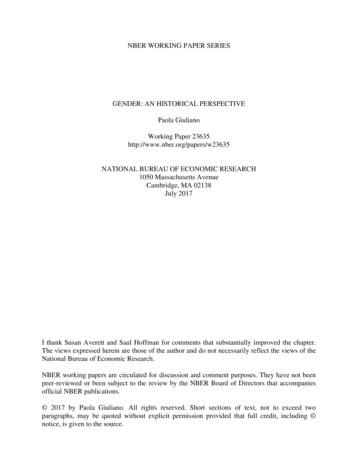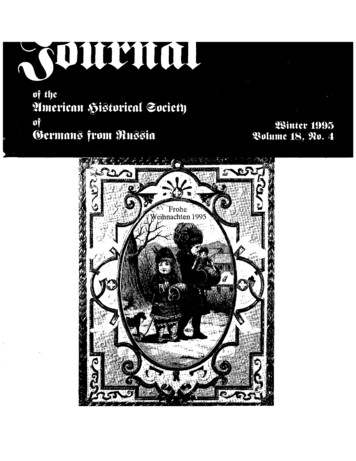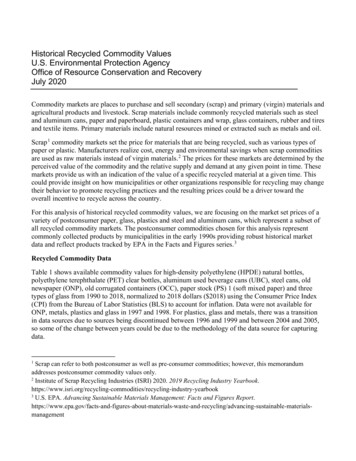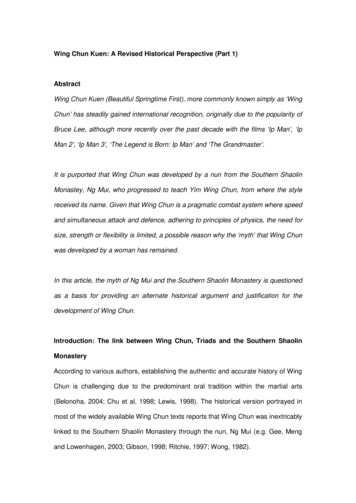
Transcription
AN HISTORICAL AND STYLISTIC EXAMINATION OF CHARLES CHAYNES’CONCERTO POUR TROMPETTE AND DEUXIÈME CONCERTO POURTROMPETTE, WITH AN INTERVIEW OF THE COMPOSERMarc Allen Reed, B.M.E., B.M., M.M.Dissertation Prepared for the Degree ofDOCTOR OF MUSICAL ARTSUNIVERSITY OF NORTH TEXASAugust 2007APPROVED:Keith Johnson, Major ProfessorEugene Corporon, Minor ProfessorJohn Holt, Committee MemberJames C. Scott, Dean of the College of MusicSandra L. Terrell, Dean of the Robert B. ToulouseSchool of Graduate Studies
Reed, Marc Allen, An historical and stylistic examination of Charles Chaynes’ ConcertoPour Trompette and Deuxième Concerto Pour Trompette, with an interview of the composer.Doctor of Musical Arts (Performance), August 2007, 59 pp., 46 examples, bibliography, 32titles.Research has been conducted on prominent mid-twentieth century French trumpetconcertos and their composers. Jolivet, Bozza, and Tomasi have all been the subject of research.Charles Chaynes’ music is equally valuable to modern trumpet repertoire as that of Jolivet,Bozza, and Tomasi. Chaynes’ exclusion from research leaves a void in resources available tofuture trumpet students. A study of Charles Chaynes and his trumpet concertos is essential topreserving the history of the valve trumpet’s young modern repertoire. Lack of understanding ofChaynes’ trumpet concertos can only lead to misconceptions when interpreting these pieces.The thirty-nine year gap between Chaynes’ Trumpet Concerto No. 1 and TrumpetConcerto No. 2 is a remarkable time span between major compositions, and examining the worksgives insight to the evolution of the trumpet concerto throughout the twentieth century. Thisproject highlights Charles Chaynes’ contribution to the trumpet repertoire from both thebeginning and end of his compositional career, and fills the research gap concerning hisconcertos. It includes correspondence with Charles Chaynes and others, in order to gaininformation not found in common source materials. It highlights examples from each concertothat are representative of the composer’s compositional style.
Copyright 2007byMarc Allen Reedii
ACKNOWLEDGEMENTSI would like to thank those who assisted me with this project: Charles Chaynes, EvaCochard-Henrichs, John Haynie, Richard Giangiulio, Eugene Corporon, and John Holt.I am in debt to Keith Johnson for his selfless patience, encouragement, and interest in mydevelopment as both a man and a musician. He is a gentleman in the truest sense of the wordand has had immeasurable influence on my life.Thanks to my family for the support and understanding they have shown through theyears, and to the Murphy family for welcoming me into their circle.To Michele who is the guiding light behind my thoughts and actions. This would nothave been possible without her caring, patience, and love.Thank you.iii
TABLE OF CONTENTSPageACKNOWLEDGEMENTS.iiiINTRODUCTION . 1Background and SignificanceState of ResearchPurposeMethodCHARLES CHAYNES BIOGRAPHY . 6TRUMPET CONCERTO NO. I. 9HistoryMovement IMovement IIMovement IIITRUMPET CONCERTO NO. II . 25HistoryMovement IMovement IIMovement IIICONCLUSION. 42APPENDIX. 43BIBLIOGRAPHY. 57iv
INTRODUCTIONBackground and SignificanceThe role of the trumpet has evolved throughout history to fit changing trends in music. Inancient times the trumpet was used in ceremonial and militaristic ways. The trumpet was firstincluded in art ensembles during the renaissance period. This instrument, known today as thenatural trumpet, was limited to notes found only in the harmonic series. The natural trumpet’slack of pitch content in lower registers led players to aspire to perform in higher tessituras, inorder to gain diatonic scale possibilities.The “Golden Age”1 of the natural trumpet occurred during the baroque period. Virtuosoperformers began taking the trumpet to new heights, and pedagogical methods were for the firsttime written. Centers of trumpeting flourished in places like Leipzig, Bologna, and Vienna. Thetrumpet was now used as a full-fledged solo instrument by Johan Sebastian Bach, GiuseppeTorelli, and Henry Purcell.The classical period relegated the trumpet to an ensemble role. Franz Joseph Haydn,Wolfgang Amadeus Mozart, and Ludwig van Beethoven all used the trumpet sparingly, perhapsdue to its non-chromatic nature. The most significant event for the trumpet in the classicalperiod was Anton Weidinger’s work with an instrument fitted with keys (like those on themodern saxophone) that gave the trumpet chromatic capabilities. Haydn and Johann NepomukHummel wrote concertos for Weidinger in 1796 and 1804 respectively. The keyed trumpet wasabandoned due to poor tone quality.2The trumpet as a solo instrument lay largely unexplored throughout the remainder of theclassical and well into the romantic periods. The invention of the valve in the early nineteenth1Edward Tarr, The Trumpet (London: B.T. Batsford LTD, 1988), 85.Reine Dahlqvist, The Keyed Trumpet and Its Greatest Virtuoso, Anton Weidinger (Nashville, TN: The Brass Press,1975). 21.21
century changed the course of trumpet history. The new chromatic instrument in the form of thevalved trumpet or cornet, increasingly gained popularity throughout the 1800’s, and was soughtafter by players and composers. The trumpet once more became a melodic voice in art music.The agility and versatility of the valve trumpet spurred a rebirth of pedagogical texts intended todevelop finger dexterity along with artistic interpretation. New interest in the trumpet was acatalyst for composers to once again write concertos and sonatas for the instrument.The twentieth century saw a boom in music written for solo trumpet. This was especiallytrue in France, where cornet tradition gave players agility on the modern instrument. TrumpetersEugène Foveau, Raymond Sabarich, Ludovic Vaillant, and later Maurice André; all lobbied fornew trumpet pieces.3 French composers responded, and concertos were written by Henri Tomasi(1948), André Jolivet (1948 and 1955), Eugene Bozza (1949), Jean Rivier (1955), CharlesChaynes (1956), Alfred Désenclos (1953), and Robert Planel (1966). The concertos of Tomasiand Jolivet are well-known in modern trumpet circles, while Chaynes’ Concerto pour Trompette4and his later Deuxième Concerto pour Trompette have been neglected.State of Current ResearchLittle has been written about Charles Chaynes or his trumpet concertos. Biographicalinformation on Mr. Chaynes is limited to standard reference sources. These works give onlyfactual information about the man and few specifics of his compositional style. Detailedresearch on Chaynes’ concertos is virtually nonexistent and long overdue.3Tarr, Trumpet, 177.For better understanding to the reader, Charles Chaynes’ 1956 Concerto pour Trompette will be referred tothroughout the rest of the document as Trumpet Concerto No. 1. This will avoid confusion when Chaynes’ 1995Deuxième Concerto is later discussed. Likewise the Deuxième Concerto will be referred to as Trumpet ConcertoNo. 2.42
There are several dissertations that deal with mid-twentieth century French trumpetmusic: The Trumpet Music of Henri Tomasi and André Jolivet, by Jack Burt; An Analysis ofElements of Jazz Style In Contemporary French Trumpet Literature, by William Schmid; and AnEssay On Eugène Bozza’s Published Compositions For Solo Trumpet With Piano or Orchestraand An Analysis of Representative Compositions, by Raul Ornelas.Chaynes’ Trumpet Concerto No.1 is briefly discussed in Stephen Garrett’s dissertation ADiscussion of the Twentieth-Century Concerto for Trumpet and Orchestra; An InvestigativeStudy of Concertos by Alexander Arutunian, Henri Tomasi, Charles Chaynes, and André Jolivet;and a Bibliography of Concertos for Trumpet and Orchestra Written and Published From 19041983. Garrett looks at each movement of Trumpet Concerto No. 1 from a pedagogicalstandpoint only; there is no historical or stylistic information given.Trumpet Concerto No. 1 is also mentioned in Norbert Carnovale and Paul Doerksen’sbook Twentieth-Century Music for Trumpet and Orchestra, 2nd edition. This text is an allinclusive list of pre-1994 twentieth-century works for trumpet. Carnovale and Doerksen writeabout the character of the concerto, give the range of the trumpet part, assign their own grade ofVI (the most challenging level), and give the approximate duration of the piece. There is nohistorical background or stylistic information given.Trumpet Concerto No. 1 is not discussed in any periodicals. There are two obscurerecordings of the work. The first is by French trumpeter Maurice Andrè in collaboration with theOrchestra of Radio Luxembourg. This undated album was released on long-play record and hasyet to be re-issued on compact disc. The second recording was performed by Eric Aubier in1995. Aubier’s recording was released on the Pierre Verany label and is currently out of print.3
Trumpet Concerto No. 2 is not mentioned in any study, text, periodical, or online source. Thereis no recording of the work in the western world and this research is the first undertaken.PurposeResearch has been conducted on prominent mid-twentieth century French trumpetconcertos and their composers. Jolivet, Bozza, and Tomasi have all been the subject of research.Charles Chaynes’ music is equally valuable to modern trumpet repertoire as that of Jolivet,Bozza, and Tomasi. Chaynes’ exclusion from research leaves a void in resources available tofuture trumpet students. A study of Charles Chaynes and his trumpet concertos is essential topreserving the history of the valve trumpet’s young modern repertoire. Lack of understanding ofChaynes’ trumpet concertos can only lead to misconceptions when interpreting these pieces.The thirty-nine year gap between Chaynes’ Trumpet Concerto No. 1 and TrumpetConcerto No. 2 is a remarkable time span between major compositions, and examining the worksgives insight to the evolution of the trumpet concerto throughout the twentieth century. Thisproject highlights Charles Chaynes’ remarkable contribution to the trumpet repertoire from boththe beginning and end of his compositional career, and fills the research gap concerning hisconcertos.MethodTwo concertos by Charles Chaynes entitled Trumpet Concerto No. 1 and TrumpetConcerto No. 2, are the subject of this study. A brief biographical sketch of the life of CharlesChaynes is given from information provided by Chaynes and from sources that discuss thecomposer.4
This study gives historical facts regarding each concerto, justifies these concerto’s placesin modern trumpet repertoire, and serves as an aide in increasing the performer’s knowledge ofthese works. The document focuses on the importance of Charles Chaynes’ concertos bydiscussing selected examples representative of his style. Large-scale formal and harmonicanalysis of this music is difficult due to non-traditional quartal and tertian harmonies, combinedwith vertical chords containing dissonant major and minor seconds.5 Discussion ofcompositional techniques is limited to its relationship to Chaynes’ compositional style. Thestylistic examination is helpful in order to better understand each concerto. The goal of thisstudy is a heightened awareness of this important music and its composer.5Norbert Carnovale and Paul Doerksen, Twentieth-Century Music for Trumpet and Orchestra (Nashville, TN: TheBrass Press, 1994), 17.5
CHARLES CHAYNES BIOGRAPHYCharles Chaynes was born July 11, 1925 in Toulouse; a French city that is today bestknown as an aviation hub and university center. His parents were professors at the ToulouseConservatory of Music where his father played and taught violin, and his mother played pianoand taught music theory. Chaynes credits his parents for sparking his interest in composing atage fifteen and preparing him for a career as a musician.6Chaynes enrolled in the Paris Conservatory following his studies in Toulouse. At theconservatory he studied harmony with Jean Gallon and composition with Darius Milhaud; healso continued to study the fugue and the violin. Several sources, including the New GroveDictionary of Music and Baker’s Biographical Dictionary, list Jean Rivier as one of Chaynes’primary teachers at the conservatory. Chaynes, interestingly, says that he never studied with oreven knew Rivier, and that any comparison made between his and Rivier’s music is false.Chaynes credits Béla Bartók, Alban Berg, and Oliver Messiaen as composers also whoinfluenced his style.7 Chaynes obtained first prizes in harmony, composition, fugue, and violinat the conservatory.8In 1951, Chaynes was awarded the first Grand Prix de Rome for his cantata Et l’hommevit se rouvrir le portes. This afforded Chaynes the opportunity to study in Rome with fundingfrom the French Government; from 1952-1955 he worked at the Académie de France in Rome.9Chaynes returned to Paris in 1956 and began working for French radio station L’ ORTF as aproducer. The composer remarks that he came to this occupation because of a simple liking for6Charles Chaynes, to Marc Reed, March 22 2007, translated by Eva Cochard-Henrichs, Denton, Texas
Chaynes’ Trumpet Concerto No.1 is briefly discussed in Stephen Garrett’s dissertation A Discussion of the Twentieth-Century Concerto for Trumpet and Orchestra; An Investigative Study of Concertos by Alexander Arutunian, Henri Tomasi, Charles Chaynes, and André Jolivet; and a Bibliography of Concertos for Trumpet and Orchestra Written and Published From 1904- 1983. Garrett looks at each .Author: Marc Allen ReedPublish Year: 2007
